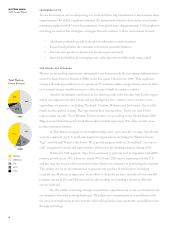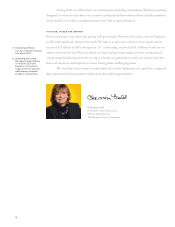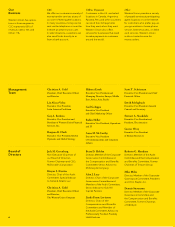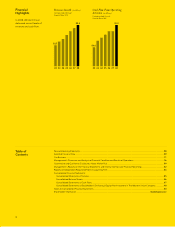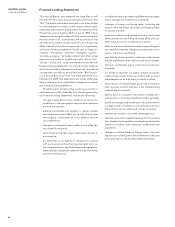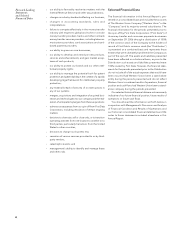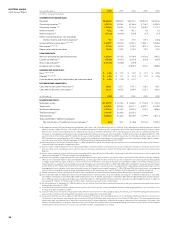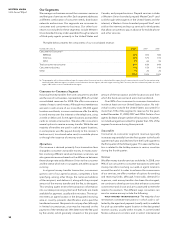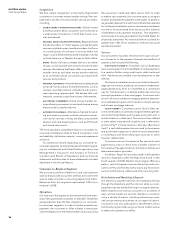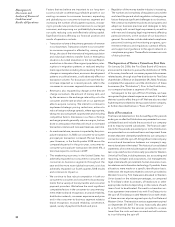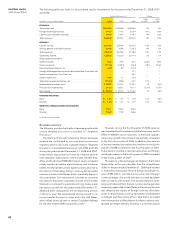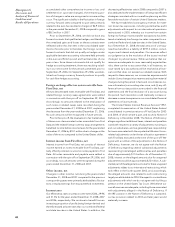Western Union 2008 Annual Report Download - page 16
Download and view the complete annual report
Please find page 16 of the 2008 Western Union annual report below. You can navigate through the pages in the report by either clicking on the pages listed below, or by using the keyword search tool below to find specific information within the annual report.WESTERN UNION
2008 Annual Report
1414
Competition
We face robust competition in the highly-fragmented
consumer-to-consumer money transfer industry. We com-
pete with a variety of money transfer service providers,
including:
º
GLOBAL MONEY TRANSFER PROVIDERS— Global money
transfer providers allow consumers to send money to
a wide variety of locations, in both their home coun-
tries and abroad.
º
REGIONAL MONEY TRANSFER PROVIDERS—Regional money
transfer providers, or “niche” players, provide the same
services as global money transfer providers, but focus
on a small group of corridors or services within one
region, such as North America to the Caribbean, Central
or South America, or Western Europe to North Africa.
º
BANKS—
Banks of all sizes compete with us in a number
of ways, including bank wire services and card-based
services. We believe that banks offer consumers wire
transfer services and other money transfer methods
as an incentive to those consumers to purchase other
services and products.
º
INFORMAL NETWORKS—
Informal networks enable people
to transfer funds without formal mechanisms, such as
receipts, and often without compliance with govern-
ment reporting requirements. We believe that such
networks comprise a significant share of the market.
º
ELECTRONIC COMMERCE— Online money transfer ser-
vices allowing consumers to send and receive money
electronically using the internet.
º
ALTERNATIVE CHANNELS—Alternative channels for send-
ing and receiving money include mail and commer-
cial courier services, money transfers using mobile
phones, and card-based options, such as ATM cards
and stored-value cards.
The most significant competitive factors in consumer-to-
consumer remittances relate to brand recognition, trust
and reliability, distribution network, consumer experience
and price.
For additional details regarding our consumer-to-
consumer segment, including financial information regard-
ing our international and United States operations, see
Management’s Discussion and Analysis of Financial
Condition and Results of Operations and our financial
statements and the notes to those statements included
elsewhere in this Annual Report.
Consumer-to-Business Segment
We provide a portfolio of electronic and cash payment
options that provide consumers with fast and convenient
ways to make one-time or recurring payments to billers.
Revenues from this segment represented 14% of our
revenue in 2008.
Operations
Our revenue in this segment is derived primarily from trans-
action fees paid by the consumer or the biller. These fees
are typically less than the fees charged in our consumer-
to-consumer segment. In order to make an electronic
payment, the consumer or biller initiates a transaction
over the telephone or the internet which we process using
the consumer’s credit card, debit card or ACH. In order
to make a cash payment, the consumer goes to an agent
location and makes the payment to the agent. In addition,
we generate revenue from upfront enrollment fees received
for our Equity Accelerator service, and we earn investment
income on funds received from services sold in advance
of settlement with payment recipients. The segment’s
revenue was primarily generated in the United States for
all periods presented. No individual biller accounted for
greater than 10% of this segment’s revenue during all
periods presented.
Services
Our consumer-to-business services strive to give consum-
ers choices as to the payment channel and method of
payment, and include the following:
ELECTRONIC PAYMENTS. Consumers use our Speedpay
service principally in the United States to make payments
to a variety of billers using credit cards, debit cards and
ACH. Payments are initiated over the telephone or the
internet.
Our Equity Accelerator service is provided in the mort-
gage service industry, enabling consumers to make mort-
gage payments by ACH. It is marketed as a convenient
way for homeowners to schedule additional recurring
principal payments on their mortgages. Consumers who
enroll in this service make mortgage payments based on
an accelerated program, which results in interest savings
and a lower mortgage balance.
CASH PAYMENTS. Consumers use our Quick Collect ser-
vice to send funds to businesses and government agencies
across the United States and Canada, using cash and, in
certain locations, a debit card. This service is also offered
in other select international locations, and is referred to
as Quick Pay
SM
in those locations. We also offer Quick
Cash®, a cash disbursement service used by businesses
and government agencies to send money to employees
or individuals with whom they have accounts or other
business relationships.
Consumers use our Convenience Pay service to send
payments by cash or check from a smaller number of
Convenience Pay agent locations primarily to utilities and
telecommunication providers.
In addition, Pago Fácil provides a walk-in bill payment
service in Argentina under the Pago Fácil brand. In the
fourth quarter of 2008, Western Union began offering a
walk-in, cash bill payment service that will provide con-
sumers in Peru and Panama with a way to pay for services
such as mobile phone, utilities and other recurring bills.
Distribution and Marketing Channels
Our electronic payment services are available primarily
through the telephone and the internet, while our cash-
based services are available through our agent networks.
Billers market our services to consumers in a number of
ways, and we market our services directly to consumers
using a variety of means, including advertising mate-
rials and promotional activities at our agent locations.
Consumers can also participate in the Western Union
Gold Card program when using our Quick Collect service
to make cash payments to billers.


